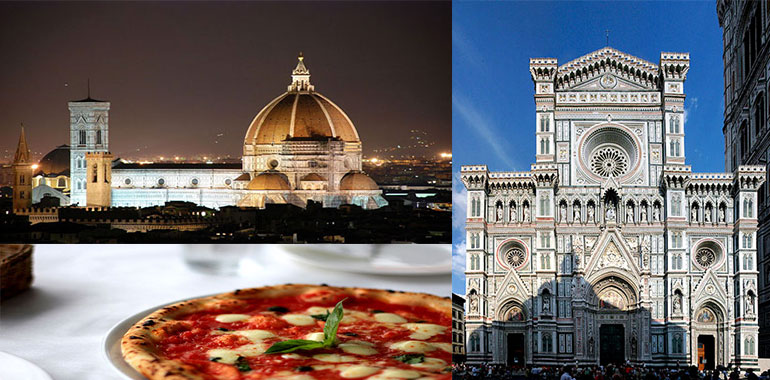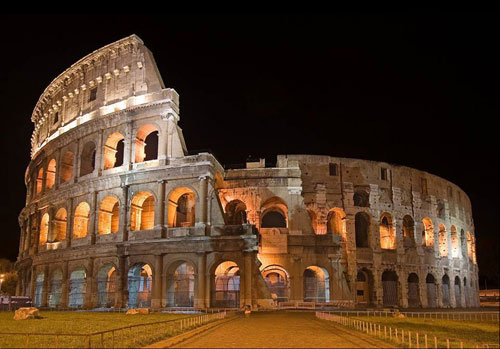
Italy, officially the Italian Republic (Italian: Repubblica italiana), is a unitary parliamentary republic in South-Central Europe. To the north, it borders France, Switzerland, Austria, and Slovenia along the Alps. To the south, it consists of the entirety of the Italian Peninsula, Sicily, Sardinia–the two largest islands in the Mediterranean Sea–and many other smaller islands.
Full name: Italian Republic
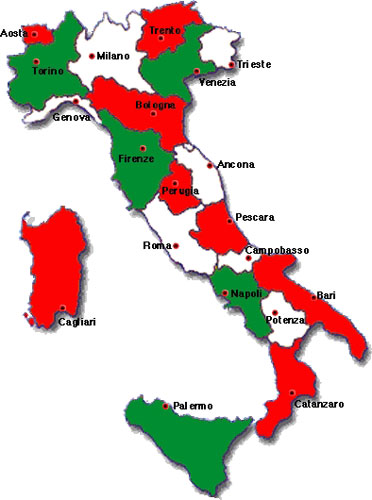
Capital: Rome
Area Total: 301.340 km²
Water %: 2,4 %
Population: 60.813.326
Density: 201.8/km2 (61st) 522.7/sq mi
Continent: Europe
Currency: Euro (€)
The independent states of San Marino and the Vatican City are enclaves within Italy, while Campione d’Italia is an Italian exclave in Switzerland. The territory of Italy covers some 301,338 km2 (116,347 sq mi) and is influenced by a temperate seasonal climate. With 60.8 million inhabitants, it is the fifth most populous country in Europe, and the 23rd most populous in the world.
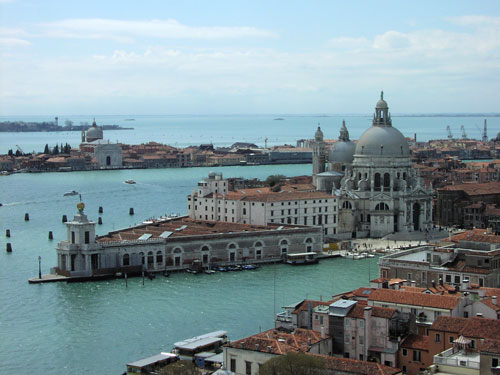
Rome, the capital of Italy, has for centuries been a political and religious centre of Western civilisation as the capital of the Roman Empire and site of the Holy See. After the decline of the Roman Empire, Italy endured numerous invasions by foreign peoples, from Germanic tribes such as the Lombards and Ostrogoths, to the Byzantines and later, the Normans, among others. Centuries later, Italy became the birthplace of Maritime republics and the Renaissance. Through much of its post-Roman history, Italy was fragmented into numerous city and regional states (such as the Republic of Venice and the Church State), but was unified in 1861. In the late 19th century, through World War I, and to World War II, Italy possessed a colonial empire.
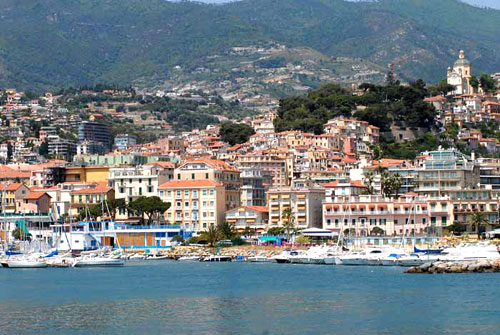
Modern Italy is a democratic republic. It has been ranked as the world’s 24th most-developed country and its Quality-of-life Index has been ranked in the world’s top ten in 2005. Italy enjoys a very high standard of living, and has a high GDP per capita. It is a founding member of what is now the European Union and part of the Eurozone. Italy is also a member of the G8, G20 and NATO. It has the world’s third-largest gold reserves, eighth-largest nominal GDP, tenth highest GDP (PPP) and the sixth highest government budget in the world. It is also a member state of the Organisation for Economic Co-operation and Development, the World Trade Organization, the Council of Europe, the Western European Union and the United Nations. Italy has the world’s ninth-largest defence budget and shares NATO’s nuclear weapons.
Italy plays a prominent role in European and global military, cultural and diplomatic affairs. The country’s European political, social and economic influence make it a major regional power. The country has a high public education level and is a highly globalised nation.
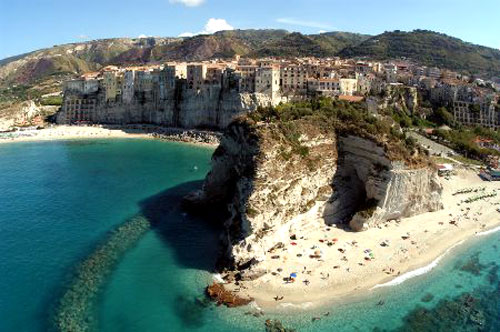
Geography
Italy is located in Southern Europe and comprises the boot-shaped Italian Peninsula and a number of islands including the two largest, Sicily and Sardinia. It lies between latitudes 35° and 47° N, and longitudes 6° and 19° E.
The country’s total area is 301,230 km², of which 294,020 km² is land and 7,210 km² is water. Including the islands, Italy has a coastline and border of 7,600 km on the Adriatic, Ionian, Tyrrhenian seas (740 km), and borders shared with France (488 km), Austria (430 km), Slovenia (232 km) and Switzerland; San Marino (39 km) and Vatican City (3.2 km), both enclaves, account for the remainder.
The Apennine Mountains form the peninsula’s backbone and the Alps form its northern boundary, where Italy’s highest point is located on Mont Blanc (4,810 m/15,782 ft). The Po, Italy’s longest river (652 km/405 mi), flows from the Alps on the western border with France and crosses the Padan plain on its way to the Adriatic Sea. The five largest lakes are, in order of diminishing size: Garda (367.94 km2/142 sq mi), Maggiore (212.51 km2/82 sq mi, shared with Switzerland), Como (145.9 km2/56 sq mi), Trasimeno (124.29 km2/48 sq mi) and Bolsena (113.55 km2/44 sq mi).
The country is situated at the meeting point of the Eurasian Plate and the African Plate, leading to considerable seismic and volcanic activity. There are 14 volcanoes in Italy, four of which are active: Etna (the traditional site of Vulcan’s smithy), Stromboli, Vulcano and Vesuvius. Vesuvius is the only active volcano in mainland Europe and is most famous for the destruction of Pompeii and Herculanum. Several islands and hills have been created by volcanic activity, and there is still a large active caldera, the Campi Flegrei north-west of Naples.
Although the country comprises the Italian peninsula and most of the southern Alpine basin, some of Italy’s territory extends beyond the Alpine basin and some islands are located outside the Eurasian continental shelf. These territories are the comuni of: Livigno, Sexten, Innichen, Toblach (in part), Chiusaforte, Tarvisio, Graun im Vinschgau (in part), which are all part of the Danube’s drainage basin, while the Val di Lei constitutes part of the Rhine’s basin and the islands of Lampedusa and Lampione are on the African continental shelf.
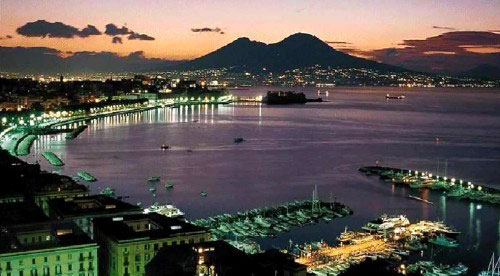
Climate
Thanks to the great longitudinal extension of the peninsula and the mostly mountainous internal conformation, the climate of Italy is highly diverse. In most of the inland northern and central regions, the climate ranges from humid subtropical to humid continental and oceanic. In particular, the climate of the Po valley geographical region is mostly continental, with harsh winters and hot summers. The coastal areas of Liguria, Tuscany and most of the South generally fit the Mediterranean climate stereotype. Conditions on peninsular coastal areas can be very different from the interior’s higher ground and valleys, particularly during the winter months when the higher altitudes tend to be cold, wet, and often snowy. The coastal regions have mild winters and warm and generally dry summers, although lowland valleys can be quite hot in summer.
Cuisine
Modern Italian cuisine has evolved through centuries of social and political changes, with its roots reaching back to the 4th century BC. Significant change occurred with the discovery of the New World, when vegetables such as potatoes, tomatoes, bell peppers, and maize became available. However, these central ingredients of modern Italian cuisine were not introduced in scale before the 18th century.
Ingredients and dishes vary by region. However, many dishes that were once regional have proliferated in different variations across the country. Cheese and wine are major parts of the cuisine, playing different roles both regionally and nationally with their many variations and Denominazione di origine controllata (regulated appellation) laws. Coffee, and more specifically espresso, has become highly important to the cultural cuisine of Italy. Some famous dishes and items include pasta, pizza, lasagna, focaccia, and gelato.
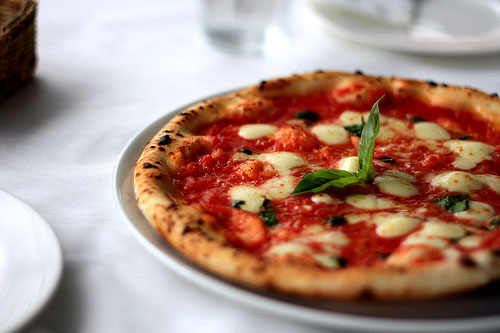
Art
Over the centuries, Italian art has gone through many stylistic changes. Italian painting is traditionally characterized by a warmth of colour and light, as exemplified in the works of Caravaggio and Titian, and a preoccupation with religious figures and motifs. Italian painting enjoyed pre-eminence in Europe for hundreds of years, from the Romanesque and Gothic periods, and through the Renaissance and Baroque periods, the latter two of which saw fruition in Italy. Other notable artists who fall within these periods include Michelangelo, Leonardo da Vinci, Donatello, Botticelli, Fra Angelico, Tintoretto, Bernini, and Raphael.
Thereafter, Italy was to experience a continual subjection to foreign powers which caused a shift of focus to political matters, leading to its decline as the artistic authority in Europe. Not until 20th century Futurism, primarily through the works of Umberto Boccioni and Giacomo Balla, would Italy recapture any of its former prestige as a seminal place of artistic evolution. Futurism was succeeded by the metaphysical paintings of Giorgio de Chirico, who exerted a strong influence on the Surrealists and generations of artists to follow.
Culture
Italy did not exist as a state until the country’s unification in 1861. Due to this comparatively late unification, and the historical autonomy of the regions that comprise the Italian Peninsula, many traditions and customs that are now recognized as distinctly Italian can be identified by their regions of origin. Despite the political and social distinction of these regions, Italy’s contributions to the cultural and historical heritage of Europe and the world remain immense. Italy is home to the greatest number of UNESCO World Heritage Sites (47) to date, and has rich collections of art, culture and literature from many different periods. The country has had a broad cultural influence worldwide, also because numerous Italians emigrated to other places during the Italian diaspora. Furthermore, the nation has, overall, an estimated 100,000 monuments of any sort (museums, palaces, buildings, statues, churches, art galleries, villas, fountains, historic houses and archaeological remains).
Colosseum
State: Italy
Region: Lazio
Province: Rome
The Colosseum, or the Coliseum, originally the Flavian Amphitheatre (Latin: Amphitheatrum Flavium, Italian Anfiteatro Flavio or Colosseo), is an elliptical amphitheatre in the centre of the city of Rome, Italy, the largest ever built in the Roman Empire. It is considered one of the greatest works of Roman architecture and Roman engineering.
Occupying a site just east of the Roman Forum, its construction started in 72 AD under the emperor Vespasian and was completed in 80 AD under Titus, with further modifications being made during Domitian’s reign (81–96). The name “Amphitheatrum Flavium” derives from both Vespasian’s and Titus’s family name (Flavius, from the gens Flavia).
Capable of seating 50,000 spectators, the Colosseum was used for gladiatorial contests and public spectacles such as mock sea battles, animal hunts, executions, re-enactments of famous battles, and dramas based on Classical mythology. The building ceased to be used for entertainment in the early medieval era. It was later reused for such purposes as housing, workshops, quarters for a religious order, a fortress, a quarry, and a Christian shrine.
Although in the 21st century it stays partially ruined because of damage caused by devastating earthquakes and stone-robbers, the Colosseum is an iconic symbol of Imperial Rome. It is one of Rome’s most popular tourist attractions and still has close connections with the Roman Catholic Church, as each Good Friday the Pope leads a torchlit “Way of the Cross” procession that starts in the area around the Colosseum.
Milan Cathedral
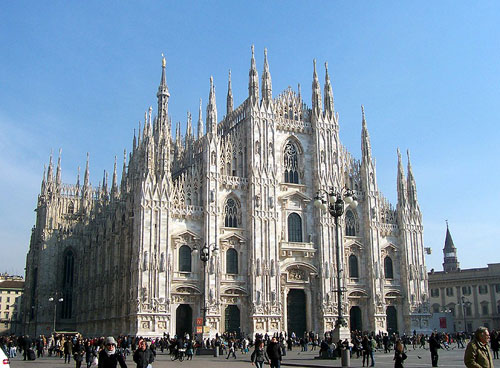
State: Italy
Region: Lombardy
Province: Milan
Coordinate: 45°27′50.98″N 9°11′25.21″E
Style: Gothic
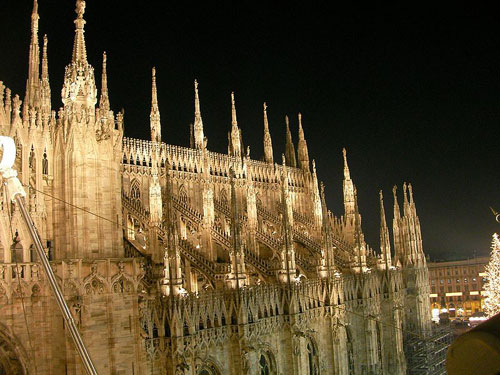
Milan Cathedral (Italian: Duomo di Milano) is the cathedral church of Milan, Italy. Dedicated to Santa Maria Nascente (Saint Mary Nascent), it is the seat of the Archbishop of Milan, currently Cardinal Angelo Scola.
The Gothic cathedral took nearly six centuries to complete. It is the fourth largest cathedral in the world[1] and the largest in the Italian state territory.
Florence Cathedral
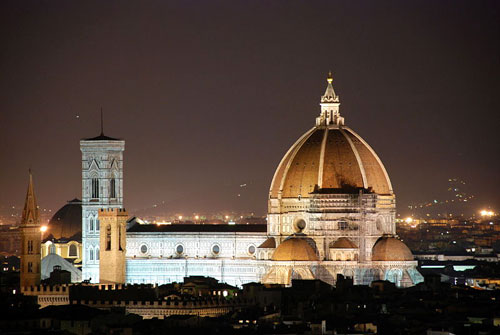
State: Italy
Region: Tuscany
Province: Florence
Coordinate: 43°46′17″N 11°15′15″E
Style: Gothic and Renaissance
The Basilica di Santa Maria del Fiore (English: Basilica of Saint Mary of the Flower) is the main church of Florence, Italy. The Duomo, as it is ordinarily called, was begun in 1296 in the Gothic style to the design of Arnolfo di Cambio and completed structurally in 1436 with the dome engineered by Filippo Brunelleschi. The exterior of the basilica is faced with polychrome marble panels in various shades of green and pink bordered by white and has an elaborate 19th century Gothic Revival façade by Emilio De Fabris.
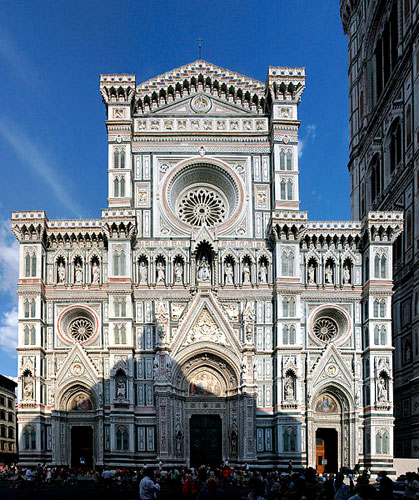
The cathedral complex, located in Piazza del Duomo, includes the Baptistery and Giotto’s Campanile. The three buildings are part of the UNESCO World Heritage Site covering the historic centre of Florence and are a major attraction to tourists visiting the region of Tuscany. The basilica is one of Italy’s largest churches, and until development of new structural materials in the modern era, the dome was the largest in the world. It remains the largest brick dome ever constructed.
The cathedral is the mother church of the Roman Catholic Archdiocese of Florence, whose archbishop is currently Giuseppe Betori.
Palace of Caserta
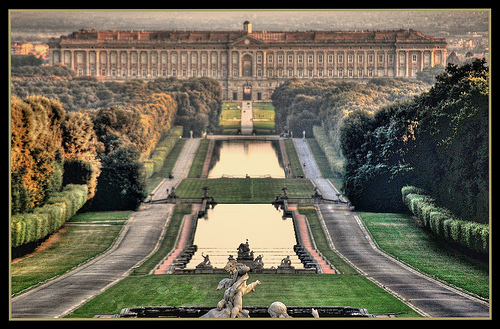
State: Italy
Region: Campania
Province: Caserta
Coordinate: 41°5′0″N 14°13′0″E
Style: Architectonic e scenic
The Royal Palace of Caserta (Italian: Reggia di Caserta) is a former royal residence in Caserta, southern Italy, constructed for the Bourbon kings of Naples. It was the largest palace and one of the largest buildings erected in Europe during the 18th century. In 1997, the Palace was designated a UNESCO World Heritage Site, described in its nomination as “the swan song of the spectacular art of the Baroque, from which it adopted all the features needed to create the illusions of multidirectional space”.

Overview
The palace has a rectangular plan, measuring 247 x 184 m. The four sides are connected by two orthogonal arms, forming four inner courts, each measuring more than 3,800 m2 (40,903 sq ft). Of all the Royal Palace in the World, Caserta Palace is by far the largest in term of volume, with more than 2 million m³ (70 million cu ft).
Behind the facades of its matching segmental ranges of outbuildings that flank the giant forecourt, a jumble of buildings arose to facilitate daily business. In the left hand arc was built as barracks. Here, later, during World War II the soldiers of the US Fifth Army recovered in a “rest centre”. From 1923 to 1943 the palace was the location of the Accademia Aeronautica, the Italian Air Force Academy.
Of all the royal residences inspired by the Palace of Versailles, the Reggia of Caserta is the one that bears the greatest resemblance to the original model: the unbroken balustraded skyline, the slight break provided by pavilions within the long, somewhat monotonous facade. As at Versailles, a large aqueduct was required to bring water for the prodigious water displays. Like its French predecessor, the palace was intended to display the power and grandeur of an absolute Bourbon monarchy. A solecism at Caserta is that above the piano reale, the King’s floor, is another floor of equal magnificence. The enfilades of Late Baroque saloni were the heart and seat of government, as well as displays of national wealth. Caserta provided a royal refuge from the dust and factions of the capital, just as Versailles had freed Louis XIV from Paris. The royal palace has more than 40 monumental rooms completely decorated with frescoes (for example, Versailles only counts 22 monumental rooms with frescoes). The inland location was more defensible than the old Royal Palace in Naples, which fronted the Bay of Naples and hence was vulnerable to attack from the sea. To provide the King with suitable protection, troop barracks were housed within the palace.
The wide central entrance carriageway has, today, been incorporated into the city’s automobile circulation.
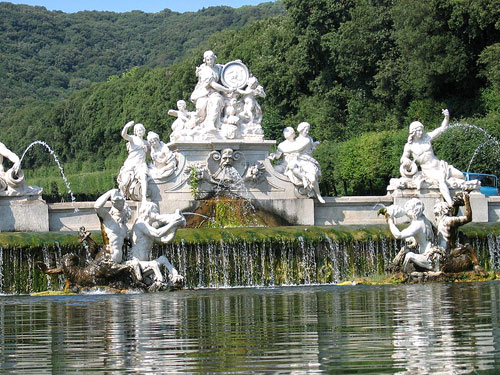
The park
The garden, a typical example of the baroque extension of formal vistas, stretch for 120 ha, partly on hilly terrain. It is inspired by the park of Versailles, but it is commonly regarded as superior in beauty. The park starts from the back façade of the palace, flanking a long alley with artificial fountains and cascades. There is a botanical garden, called “The English Garden,” in the upper part designed in the 1780s by Carlo Vanvitelli and the German-born botanist, nurseryman, plantsman-designer John Graefer, trained in London and recommended to Sir William Hamilton by Sir Joseph Banks. It is an early Continental example of an “English garden” in the svelte naturalistic taste of Capability Brown.
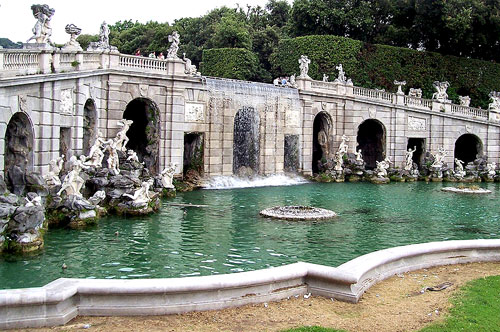
The fountains and cascades, each filling a vasca (“basin”), with architecture and hydraulics by Luigi Vanvitelli at intervals along a wide straight canal that runs to the horizon, rivalled those at Peterhof outside St. Petersburg. These include:
• The Fountain of Diana and Actaeon (sculptures by Paolo Persico, Brunelli, Pietro Solari);
• The Fountain of Venus and Adonis (1770–80);
• The Fountain of the Dolphins (1773–80);
• The Fountain of Aeolus;
• The Fountain of Ceres
A large population of figures from classical Antiquity were modelled by Gaetano Salomone for the gardens of the Reggia, and executed by large workshops.

